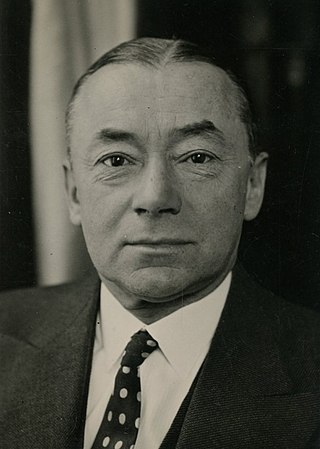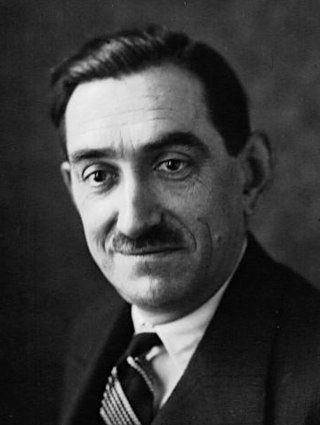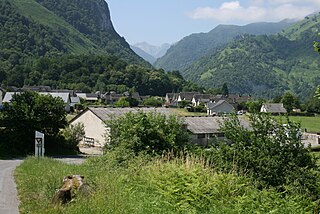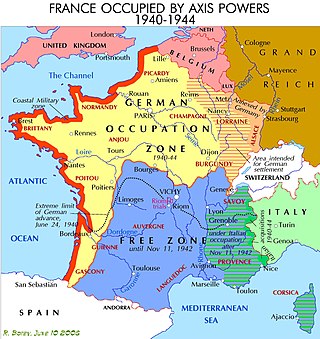
Henri Philippe Bénoni Omer Joseph Pétain, better known as Philippe Pétain and Marshal Pétain, was a French general who commanded the French Army in World War I and later became the head of the collaborationist regime of Vichy France, from 1940 to 1944, during World War II.

André Léon Blum was a French socialist politician and three-time Prime Minister of France. As a Jew, he was heavily influenced by the Dreyfus affair of the late 19th century. He was a disciple of socialist leader Jean Jaurès. After Jaurès' assassination in 1914, he became his successor.

Paul Reynaud was a French politician and lawyer prominent in the interwar period, noted for his stances on economic liberalism and militant opposition to Nazi Germany.

Édouard Daladier was a French Radical-Socialist (centre-left) politician, and the Prime Minister of France who signed the Munich Agreement before the outbreak of World War II.

Major-General Sir Edward Louis Spears, 1st Baronet, was a British Army officer and Member of Parliament noted for his role as a liaison officer between British and French forces in two world wars. From 1917 to 1920 he was head of the British Military Mission in Paris, ending the war as a Brigadier-General. Between the wars he served as a Member of the British House of Commons, before once again becoming as Anglo-French liaison officer, this time as a Major-General, in the Second World War.

Georges Mandel was a French Jewish journalist, and politician.

Philippe Henriot was a French poet, journalist, politician, and Nazi collaborator who served as a minister in the French government at Vichy, where he directed propaganda broadcasts. He was assassinated by the Résistance in 1944.
The Eighty were a group of elected French parliamentarians who, on 10 July 1940, voted against the constitutional change that effectively dissolved the Third Republic and established the authoritarian regime of then-Prime Minister Philippe Pétain. Their efforts failed, and Pétain consolidated his regime into the client state of Nazi Germany now known as Vichy France.

Somport or Col du Somport, known also as the Aspe Pass or Canfranc Pass, is a mountain pass in the central Pyrenees on the border of France and Spain. Its name is derived from the Latin Summus portus. It was one of the most popular routes for soldiers, merchants, and pilgrims to the tomb of St. James following the route from Arles to cross the Pyrenees. They travelled from Oloron-Sainte-Marie, Pyrénées-Atlantiques, France, via Somport to Aragon, Spain.
The Riom Trial was an attempt by the Vichy France regime, headed by Marshal Philippe Pétain, to prove that the leaders of the French Third Republic (1870–1940) had been responsible for France's defeat by Germany in 1940. The trial was held in the city of Riom in central France, and had mainly political aims – namely to project the responsibility of defeat onto the leaders of the left-wing Popular Front government that had been elected 3 May 1936.

The scuttling of the French fleet at Toulon was orchestrated by Vichy France on 27 November 1942 to prevent Nazi German forces from seizing it. After the Allied invasion of North Africa, the Germans invaded the territory administered by Vichy under the Armistice of 1940. The Vichy Secretary of the Navy, Admiral François Darlan, defected to the Allies, who were gaining increasing support from servicemen and civilians. His replacement, Admiral Gabriel Auphan, guessed correctly that the Germans intended to seize the large fleet at Toulon, and ordered it scuttled.

Numerous internment camps and concentration camps were located in France before, during and after World War II. Beside the camps created during World War I to intern German, Austrian and Ottoman civilian prisoners, the Third Republic (1871–1940) opened various internment camps for the Spanish refugees fleeing the Spanish Civil War (1936–1939). Following the prohibition of the French Communist Party (PCF) by the government of Édouard Daladier, they were used to detain communist political prisoners. The Third Republic also interned German anti-Nazis.

The Révolution nationale was the official ideological program promoted by the Vichy regime which had been established in July 1940 and led by Marshal Philippe Pétain. Pétain's regime was characterized by anti-parliamentarism, personality cultism, xenophobia, state-sponsored anti-Semitism, promotion of traditional values, rejection of the constitutional separation of powers, and corporatism, as well as opposition to the theory of class conflict. Despite its name, the ideological policies were reactionary rather than revolutionary as the program opposed almost every change introduced to French society by the French Revolution.

Accous is a commune in the Pyrénées-Atlantiques department in the Nouvelle-Aquitaine region in southwestern France.

The Camp de Rivesaltes, also known as Camp Joffre, was an internment and transit camp in the commune of Rivesaltes in the department of Pyrénées-Orientales of the French Southern Zone during World War Two. Between August 11 and October 20, 1942, 2,313 foreign Jews, including 209 children were transferred from Rivesaltes via the Drancy internment camp to the Nazi extermination camp Auschwitz, where they were murdered. Serge Klarsfeld described the camp as the Drancy of the Southern Zone.

Located in the French Pyrenees mountains, the Chemin de la Mâture is a 1,200-metre (3,900 ft) path cut into a sheer rock face rising over 200 metres (660 ft) above the river Gave d'Aspe. Completed by the engineer Paul-Marie Leroy in 1772, the Chemin de la Mâture was originally created to transport timber from the nearby Pacq forest to be used in constructing masts for French naval vessels. The path has since been incorporated into the GR 10, a long-distance footpath running along the Pyrenees from the Atlantic Ocean to the Mediterranean Sea.

The zone libre was a partition of the French metropolitan territory during World War II, established at the Second Armistice at Compiègne on 22 June 1940. It lay to the south of the demarcation line and was administered by the French government of Philippe Pétain based in Vichy, in a relatively unrestricted fashion. To the north lay the zone occupée, in which the powers of Vichy France were severely limited.
The Aspe Valley is a valley in the French part of the Pyrenees, department of Pyrénées-Atlantiques.

The Government of Vichy France was the collaborationist ruling regime or government in Nazi-occupied France during the Second World War. Of contested legitimacy, it was headquartered in the town of Vichy in occupied France, but it initially took shape in Paris under Marshal Philippe Pétain as the successor to the French Third Republic in June 1940. The government remained in Vichy for four years, but fled to Germany in September 1944 after the Allied invasion of France. It operated as a government-in-exile until April 1945, when the Sigmaringen enclave was taken by Free French forces. Pétain was brought back to France, by then under control of the Provisional French Republic, and put on trial for treason.

The French constitutional Law of 2 November 1945 was an interim, transitional constitutional law that set a legal basis for government in France under the Provisional Government of the French Republic (GPRF) for one year until a new constitution was approved.


















